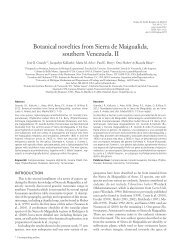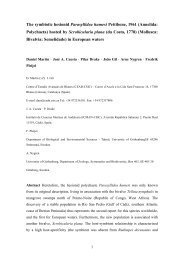FUNCTIONAL AND BIOACTIVE PROPERTIES OF COLLAGEN AND ...
FUNCTIONAL AND BIOACTIVE PROPERTIES OF COLLAGEN AND ...
FUNCTIONAL AND BIOACTIVE PROPERTIES OF COLLAGEN AND ...
You also want an ePaper? Increase the reach of your titles
YUMPU automatically turns print PDFs into web optimized ePapers that Google loves.
formation and stabilisation (Townsend & Nakai, 1983). In this respect, the foam capacity of gelatin<br />
from farmed giant catfish was found to be higher than that from calf skin, the difference possibly<br />
being due to the higher content of hydrophobic amino acid residues in the former. Moreover, the<br />
almost 4 times greater viscosity of the farmed giant catfish skin gelatin was also one of the main<br />
reasons for its better foam stability (Jongjareonrak et al., 2010).<br />
4.3.- Film-forming properties<br />
Gelatin has been extensively studied on account of its film-forming ability and its usefulness as an<br />
outer film to protect food from drying and exposure to light and oxygen (Arvanitoyannis, 2002).<br />
Furthermore, there is an important trend in favour of the use of biodegradable films made from edible<br />
biopolymers from renewable sources to combat the environmental impact of plastic waste<br />
(Tharanathan, 2003). The highly hygroscopic nature of gelatin is its main drawback when considering<br />
the use of gelatin films as protective barriers, because they tend to swell or dissolve when in contact<br />
with the surface of foodstuffs with high moisture content. Consequently, the current trend in<br />
designing gelatin-based biodegradable materials for food packaging or biomedical applications is<br />
focused on developing films with improved mechanical and water resistance properties, by combining<br />
gelatin with biopolymers with different characteristics, such as lipids (Bertan, Tanada-Palmu, Siani,<br />
& Grosso, 2005; Pérez-Mateos, Montero & Gómez-Guillén, 2009; Limpisophon, Tanaka, & Osako,<br />
2010), soy protein isolates (Cao, Fu, & He, 2007; Denavi, Pérez-Mateos, Añón, Montero, Mauri, &<br />
Gómez-Guillén, 2009), polysaccharides as gellan (Lee, Shim, & Lee, 2004), konjac glucomannan<br />
(Li, Kennedy, Jiang, Xie, 2006), chitosan (Arvanitoyannis, Nakayama & Aiba, 1998) pectins (Liu,<br />
Liu, Fishman & Hicks, 2007; Farris et al., 2009), new hydrophobic or hydrophilic plasticizers<br />
(Andreuccetti, Carvalho, & Grosso, 2009; Cao, Yang, & Fu, 2009), synthetic polymers such as<br />
poly(vinyl) alcohol (Carvalho et al., 2009) or polyethylene (Haroun, Beherei, & Abd El-Ghaffar,<br />
2010a), as well as cross-linking agents, such as glutaraldehyde (Bigi, Cojazzi, Panzavolta, Rubini, &<br />
Roveri, 2001), TGase or 1-ethyl-3-(3-dimethylamino-propyl) carbodiimide (EDC) (Yi, Kim, Bae,<br />
Whiteside, & Park, 2006; Kolodziejska & Piotrowska, 2007).<br />
The effect on film properties of gelatin attributes, especially from fish origin, was reviewed recently<br />
by Gómez-Guillén et al. (2009). The molecular weight distribution and amino acid composition,<br />
which are the main factors influencing the physical and structural properties of gelatin, are also<br />
believed to play a key role in the mechanical and barrier properties of the resulting films. Weaker and<br />
more deformable films are normally obtained when low-molecular weight fragments predominate in a<br />
given gelatin preparation, which may be caused by protein heat degradation during the water<br />
extraction step (Muyonga, Cole & Duodu, 2004a) or during the evaporation step (Carvalho et al.,<br />
2008). Furthermore, films made using a lower-molecular weight gelatin were found to be more<br />
plasticized, as a result of the higher plasticizer:biopolymer molar ratio (Thomazine, Carvalho &<br />
14

















